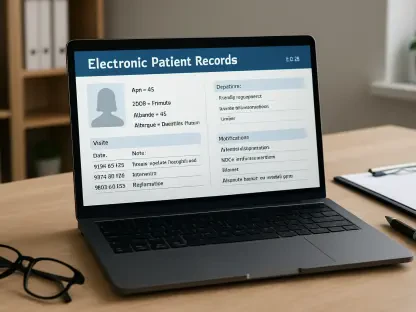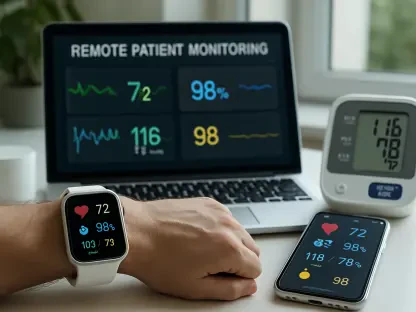In a world where digital transformation has fundamentally changed the healthcare sector, protecting sensitive data is paramount. Healthcare providers are increasingly moving to cloud environments to benefit from scalability, cost-efficiency, and flexibility. However, this shift comes with significant challenges, particularly in safeguarding Protected Health Information (PHI). PHI includes an individual’s medical history, treatment plans, and even financial details, making it a prime target for cybercriminals. As cyber threats continue to evolve, so must the strategies to protect this valuable information, demanding a careful equilibrium between leveraging cloud benefits and ensuring data integrity.
Navigating Regulatory Compliance in Cloud Storage
Understanding HIPAA and GDPR Requirements
Compliance with regulations such as the Health Insurance Portability and Accountability Act (HIPAA) in the United States and the General Data Protection Regulation (GDPR) in Europe is non-negotiable for healthcare entities utilizing cloud services. These regulations establish stringent guidelines to ensure the confidentiality, integrity, and availability of sensitive data. Organizations must execute comprehensive measures, including encryption and strict access controls, to adhere to these legal standards. Encryption ensures that even if data is intercepted, it remains unreadable without the correct decryption key, providing an essential layer of security.
Healthcare organizations should also prioritize implementing robust access management systems, such as Identity and Access Management (IAM), which enable regulated access to data. IAM systems ensure that only authorized personnel can access PHI, reducing exposure to potential breaches. Regular risk assessments further enhance compliance efforts by identifying, analyzing, and mitigating security vulnerabilities. Importantly, failing to uphold these compliance regulations can result in severe legal ramifications, including hefty fines and penalties, making rigorous adherence a central focus for all healthcare providers.
Shared Responsibility Model in Cloud Security
Utilizing cloud services for healthcare data storage requires a nuanced understanding of the shared responsibility model between cloud providers and healthcare entities. Cloud service providers are typically responsible for the security of the cloud infrastructure itself, such as data centers and underlying hardware. However, the onus of protecting the data stored within these environments falls upon the healthcare organizations. This division of responsibility necessitates that healthcare providers enforce stringent security measures, including configuring access controls and ensuring proper encryption protocols are consistently in place.
Collaborating with cloud providers who demonstrate compliance with relevant regulations is crucial. Healthcare organizations should partner with providers offering robust access controls, encryption methods, and comprehensive security features. By selecting HIPAA-compliant providers like Amazon Web Services (AWS), Microsoft Azure, or Google Cloud Platform, healthcare entities can establish a foundational layer of security to protect PHI. Ultimately, this partnership allows healthcare providers to focus on managing and securing their PHI, while the cloud providers handle the infrastructure.
Strategies to Combat Cybersecurity Threats
Addressing Misconfigurations and Emerging Threats
Misconfigurations in cloud environments present a significant risk to PHI, often leading to unintended exposure of sensitive data. Such oversights can stem from manual errors or a lack of comprehensive understanding of system architectures. Addressing these vulnerabilities necessitates diligent monitoring and auditing to identify and rectify any unauthorized configurations swiftly. Real-time monitoring of cloud activities allows organizations to detect anomalies indicative of potential security breaches, offering an opportunity to respond proactively and mitigate threats before they manifest into full-scale data breaches.
Additionally, the ever-evolving cybersecurity landscape underscores the importance of adopting advanced security measures to counter emerging threats like ransomware and phishing attacks. Implementing multi-layered security protocols, including multi-factor authentication (MFA), fortifies defenses by requiring multiple forms of verification before granting access to sensitive information. Ensuring these security practices are embedded into the organizational culture can significantly reduce the risk of unauthorized access and data breaches.
Importance of Secure Cloud Architecture Design
Designing a secure cloud architecture is critical in safeguarding PHI and involves implementing multiple security measures aimed at minimizing access to sensitive data. One such measure is the principle of least privilege, which entails granting users only the access necessary to perform their roles. By restricting unnecessary permissions, this strategy reduces the potential impact of compromised user credentials. Additionally, employing firewalls to segregate workloads and protect sensitive data from unauthorized access adds another layer of security.
Routine audits and logging of activities within the cloud environment are vital in maintaining security. Keeping detailed logs of accesses and modifications to data enables organizations to track user activities and identify any suspicious behavior that may signify a security breach. Furthermore, engaging in regular security reviews ensures that enforced protocols remain effective against new and evolving threats. The cumulative impact of these strategies is a robust cloud architecture capable of withstanding and mitigating security challenges.
Building Resilience Through Training and Preparedness
Regular Backups and Disaster Recovery Plans
Securing healthcare data is not merely about preventing breaches but also about establishing resilience in recovering from them should they occur. Regular data backups and comprehensive disaster recovery plans enable healthcare organizations to bounce back quickly and continue critical operations with minimal disruption. By storing backups in secure, offsite locations, organizations ensure data availability even in the event of significant system failures or security incidents. Implementing and testing these recovery plans regularly is crucial to ascertain their effectiveness when they’re most needed.
Moreover, implementing automated backup solutions can streamline the backup process, reducing the likelihood of human error and ensuring data synchronization across all storage environments. Such solutions safeguard data integrity, further fortifying an organization’s ability to recover from unforeseen incidents. These practices, when integrated into an organization’s operational framework, can significantly enhance data resilience and mitigate the impact of potential data loss or corruption.
Employee Training and Awareness Programs
Often, the most substantial threats to security stem not from technology itself, but from human factors. Comprehensive training and awareness programs play a pivotal role in cultivating a security-first mindset among healthcare employees. Through structured training, employees learn to recognize and respond to common threats like phishing attempts, thereby reducing the likelihood of successful social engineering attacks. Empowering employees to identify and report suspicious activities helps establish a security-conscious culture that actively contributes to PHI protection.
Regular training sessions should be an integral part of an organization’s security strategy, covering a wide range of security best practices, including secure login procedures and the importance of regularly updating passwords. Additionally, simulated phishing exercises can help employees practice recognizing threats in a safe environment, thereby enhancing their ability to react appropriately in real-world scenarios. By educating the workforce to act as the first line of defense, healthcare organizations can substantially mitigate the risks associated with human error and malicious intent.
A Path Forward in Securing Healthcare Data
In today’s world, digital transformation has fundamentally changed the healthcare sector, making the protection of sensitive data a top priority. Healthcare providers are increasingly moving to cloud environments to benefit from scalability, cost efficiency, and flexibility. However, this shift comes with its own set of significant challenges, particularly in safeguarding Protected Health Information (PHI). PHI includes an individual’s medical history, treatment plans, and even financial details, which makes it a prime target for cybercriminals. As cyber threats continue to evolve, so too must the measures employed to protect this valuable information. It requires a careful equilibrium between taking advantage of cloud-based benefits and ensuring data integrity and security. The perpetual nature of cyber threats necessitates constant adaptations in security strategies, ensuring robust protection mechanisms are in place to forestall breaches. Ensuring the confidentiality, availability, and integrity of PHI in the cloud is not just crucial, but a mandatory undertaking.









